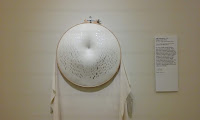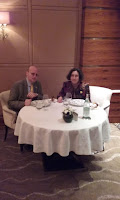Making bread is my most recent achievement in my
ongoing experiments of new recipes. I tried different alternative flours and
mixed them up. I also pinched some recipes from my mother in law who is a great
cook and uses old recipes dating back to a time when they didn’t have scales
but handfuls to measure flour and sugar; it was rough but never failed. I
translated the handfuls in grams to make them more predictable and intelligible,
though maybe less precise. My mother in law also gave me her cantucci and
frappe recipes which are a bit different from the ones I posted in the past.
There is always something new to learn in life and in cooking, which is an
important activity that precedes eating, essential to our survival and well
being. As Margaret Atwood puts it: ‘Eating is our earliest metaphor…we eat
before we talk’ (The Canlit Foodbook,
p 2), spot on.
Malted
bread
Mix 400 g of malted flour with 100 g of farina
di semola (semolina flour or durum wheat flour), add one tbsp. of olive oil,
one tbsp. of sugar, half a tsp of salt, a sachet of yeast (7 g) and 300 ml of
lukewarm water. Knead the dough and add
flour if necessary. Let it rest in a bowl in a warm place for 2-3 hours covered
with a damp tea towel.
Form a loaf of bread or some bread rolls and set
them on a greased oven tray, cover the rolls with film and let them rest for
another hour in a warm place. Bake for 20-30 minutes at 200° C.
Spelt
bread
Mix 400 g of spelt flour with three tbsp. of
olive oil, add a sachet of yeast (7 g), half a tsp of salt, some white pepper,
half a tsp of sage, half a tsp of mustard seeds, one and a half tsp of fennel
seeds and 300 ml of lukewarm water. Knead the dough and add flour if necessary.
Let it rest in a bowl in a warm place for 2-3 hours covered with a damp tea
towel.
Form a loaf of bread or some bread rolls and set
them on a greased oven tray, cover the rolls with film and let them rest for
another hour in a warm place. Bake for 20-30 minutes at 200° C.
You can have a similar mixture for the
unleavened spelt bread with 400 g of spelt flour, three tbsp. of olive oil,
salt and 200 ml of lukewarm water. Knead the dough and let it rest for one hour
only, then you can form small pizzas and fry or bake them (15-20 minutes at 200° C) sprinkling
them with sage, salt and fennel seeds.
Spelt
loaf filled with zucchini
Prepare the dough with 250 g of spelt flour, two
tbsp. of olive oil, salt and 120 ml of lukewarm water. Knead the dough and let
it rest for one hour. Cut two courgettes in little cubes and cook them in a
frying pan with half an onion thinly cut. When it is ready and cold mix it with
an egg and some grated mozzarella. Roll out the dough and spread the courgettes
mixture on it. Wrap the spelt dough around the courgettes and seal it with some
water. Bake on a greased oven tray for half an hour at 200° C.
You can have different kinds of fillings as
well, e.g., grated cheese and ham cut in cubes, or mushrooms (previously sliced
and cooked with oil, salt and parsley) and mozzarella, or ricotta and spinach.
Spelt
flour rhubarb crumble
For the crumble you need: 100 g of white flour,
100 g of spelt flour, 70 g of golden caster sugar, 150 g of unsalted diced
butter.
For the fruit mixture you need: two rhubarb
stalks, 200 g of strawberries, the juice of half a lemon, the grated zest of a
lemon, one tbsp. of golden caster sugar, half a tsp of sweet cinnamon, the tip
of a spoon of ground cloves.
 Cut the fruit and rhubarb in pieces and mix them
with lemon and spices, let it rest for 30 minutes. Mix the ingredients for the
crumble and rub it with your fingers. Spread the fruit mixture on a baking dish
and cover it with the crumble mixture. Bake for 30-45 minutes at 200° C and
serve with cream or ice-cream.
Cut the fruit and rhubarb in pieces and mix them
with lemon and spices, let it rest for 30 minutes. Mix the ingredients for the
crumble and rub it with your fingers. Spread the fruit mixture on a baking dish
and cover it with the crumble mixture. Bake for 30-45 minutes at 200° C and
serve with cream or ice-cream.
You can also have a different fruit mixture with
two rhubarb stalks, 200 g of plums, the juice of half a lemon and the grated
zest of a lemon, one tbsp. of Demerara sugar, half a tsp of sweet cinnamon,
half a tsp of ground ginger.
And here is my mother in law’s recipes
Ricotta
ciambellone (doughnut cake with ricotta)
You need: 350 g of white flour, 180 g of caster
sugar, one pinch of salt, four eggs, one and a half tsp of baking powder, one
tsp of bicarbonate of soda, four tbsp. of sunflower oil, 250 g of ricotta, 100
g of chocolate chips, two tbsp. of liquor, the grated zest of a lemon.
Grind the sugar and the zest of the lemon in a
blender. Beat the eggs and add them to the sugar and lemon mixture. Add all the
other ingredients and amalgamate them until you have a smooth mixture. Grease a
doughnut tin and sprinkle a tbsp. of Demerara sugar on the bottom before
pouring the mixture in it. Bake for 45 minutes at 180° C.
Cantucci
(or tozzetti, almond cookies)
You need 500 g of flour, three eggs, 200 g of
whole chopped almonds, five tbsp. of sunflower oil, half a glass of white wine,
one tsp of baking powder, a pinch of salt, three tbsp. of honey and 200 g of
sugar.
Mix all the ingredients in a bowl until you have
a sticky dough. Form sort of loaves and set them on a greased oven tray. Bake
for half an hour at 180°
C, then cut the loaves in slices about half an inch thick. Bake the biscuit for
another 15-20 minutes or till ready.
Frappe
You need: 250 g of flour, one egg, one tbsp. of
olive oil, one tbsp. of sugar, half a tsp of baking powder, one pinch of salt,
eight tbsp. of Prosecco, melted butter to spread on and plenty of icing sugar
to decorate.
Mix all the ingredients and divide the dough in
three parts. Roll it out and spread some butter on it then fold it over. Butter
it again and fold it for three times in total. Roll the dough out using a pasta
machine till the penultimate thickness setting. Cut the frappe with a pastry
wheel and fry in hot sunflower oil but don’t let them turn brown. Finally
sprinkle the frappe with icing sugar.
I will come back with my blog posts in September
with new recipes, reviews, travel journals and more. Let’s take a break.





















